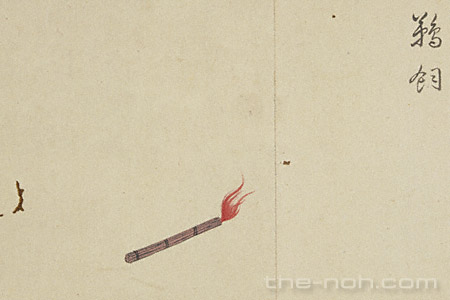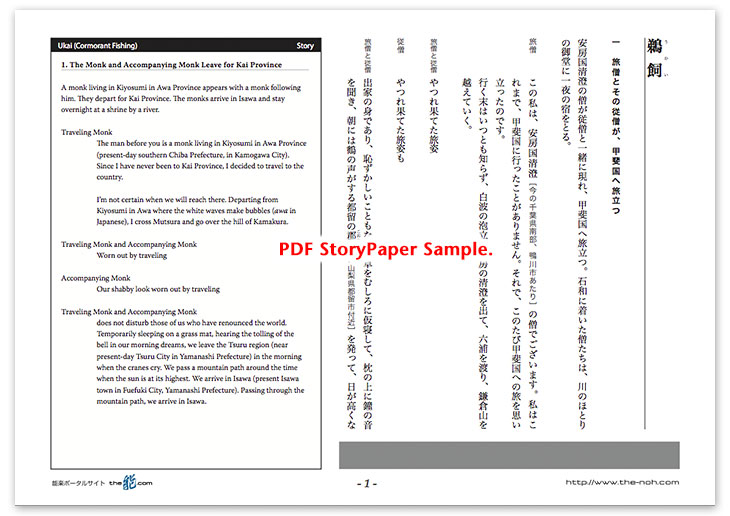
 Ukai (Cormorant Fishing)
Ukai (Cormorant Fishing)

![]()
A monk living in Kiyosumi in Awa Province (present-day southern Chiba Prefecture, in Kamogawa City) departs for Kai Province (in present-day Yamanashi Prefecture) with a companion monk. They arrive at Isawa (in present-day Fuefuki City, Yamanashi Prefecture). Since the sun has set, they decide to stay the night at a shrine standing along the Isawa River. An old cormorant fisherman appears with a torch and exchanges words with the monks. The monk who observes the aging cormorant fisherman tries to persuade him to change his job in order to quit killing living things. The old man however responds that it is too late for him to do so. The companion monk, who is listening to the conversation, remembers that he was treated to a meal by a cormorant fisherman when he visited this area a few years earlier. He mentions the fact, and the old man responds that the fisherman was killed since he broke the precept against taking life. The old man gives the account of the event and reveals that he is the ghost of the killed cormorant fisherman. After showing the way of fishing using cormorants, the ghost disappears in the darkness.
After hearing the tragic death of the cormorant fisherman from the villager, the monks write a verse of the Lotus Sutra on stones on the riverbank and pray for the fisherman’s soul. King Yama, the lord of the realm of the dead, appears to notice that the old man who was supposed to descend into hell due to his sin of killing is now saved because of the merit he achieved from offering the feast to the accompanying monk. Then, King Yama praises the precious benefits of the Lotus Sutra and recommends having mercy for taking good care of monks.
![]()
This piece includes the highlights, which graphically describes the past events just as if they are restaged in front of your eyes. The highlights include the scene of “U-no-dan (the scene of cormorant fishing)” which shows how a fisherman manipulates cormorants from a boat at night under the light of torches, the scene which describes the severe punishment issued on breaking the precept prohibiting fishing, and the scene of the offering of writing the verse of the Lotus Sutra on stones. These scenes convey a subtle antiquity.
Further, the entire piece emphasizes the wonderfulness of Buddhism and the Lotus Sutra. We can glimpse aspects of ancient beliefs.
It is also held that the traveling monk is Saint Nichiren himself, who was devoted to ascetic training at Kiyosumi.
“Delight at the beginning but sadness is left when the cormorant fishing boats are gone.” This famous haiku poem composed by Matsuo Bashō feelingly describes the world of this story.
STORY PAPER : Ukai (Cormorant Fishing)
Story Paper presents noh chant stories in modern speech, with story outlines, highlights and more using Adobe PDF format, which can print out and zoom in. Print out the pages and take them with you when you see the actual noh performance.

The copyright of Story Paper is held by the Noh.com. Story Paper is for individual use only. It is prohibited by the copyright law to distribute or publish printed-out Story Paper pages without prior consent. For more information, check the credit and disclaimer pages.



 [Ukai (Cormorant Fishing) : Story Paper PDF : 490KB
[Ukai (Cormorant Fishing) : Story Paper PDF : 490KB